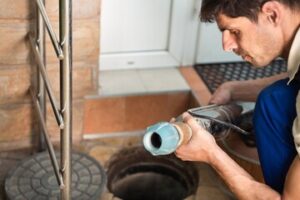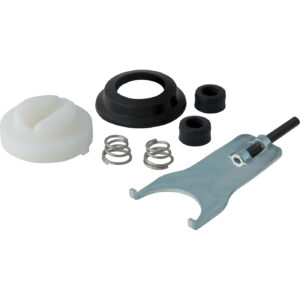Hydro jetting is a safe and effective way to clear stubborn clogs without the use of chemical drain cleaners. Before using the powerful water jet, a plumber will inspect your pipes with a camera to ensure that they can withstand this intense pressure.

Restaurant plumbing often experiences severe clogs due to FOG (fats, oils and grease) that congeal on the pipe walls. A snake can’t always remove this debris, so hydro jetting is an excellent solution. Visit Website to learn more.
Hydro jetting is a safe technique for pipes when done by a qualified plumber. The focused jets of water clean out anything that is clogging the drain or pipe, including tree roots. The force of the water is similar to that used in a pressure washer, but is directed at the specific area where it needs to be cleaned. The nozzles are designed to not come in contact with the sides of the pipe, so that damage is minimal. It is also a good idea to use the right nozzle for the job, to prevent unnecessary water loss and to avoid over-spray.
The high-powered water can break up clogs that traditional plumbing snakes and augers can’t remove. In addition, it is a better way to get rid of grease, mineral buildup, and other debris that accumulates in the drain and sewer lines. This helps to keep the drain and sewer line flowing smoothly, and it prevents blockages from recurring.
Before the plumber starts to spray the pipes with the water hose, they should inspect the line using a camera. This will reveal any damage to the pipe and help determine which treatment is best. It will also tell them if the pipe is prone to cracking. The plumber can then take measures to protect the pipeline.
If the line is prone to cracking, the plumber may suggest that it be replaced altogether, rather than using hydro jetting. It’s a quick, effective method for clearing clogs, but it’s not suitable for older pipes. The force of the water can rip apart weakened or cracked pipes, which can lead to further problems down the line.
Hydro jetting can also be harmful to the environment, if not performed properly. It is important to understand the risks and to hire a professional plumber to perform this task. They will know how to safely and effectively use the nozzles to protect the surrounding environment and prevent damage. Additionally, they can advise you on what precautions to take to protect yourself and your family from the hazards involved.
Effectiveness
Hydro jetting is one of the most effective drain cleaning methods available. It reaches difficult to access areas in your plumbing system, removing debris and blockages and leaving your pipes clean. The pressurized water also makes it much more difficult for grime and clogs to form again. This means you will need to call your plumber less often, saving money in the long run.
Another benefit of hydro jetting is that it is non-invasive. Traditional drain cleaning techniques involve digging up your garden or driveway to access clogged sewer lines, which can be time consuming and expensive. With hydro jetting, your plumber will only need to enter the clogged sewer line through the cleanout and spray the line with high-pressure water.
The power of this water can remove even the toughest clogs, including tree roots. You will also find that it can resolve minor clogs before they become serious problems. If left untreated, these clogs can cause plumbing system failure in the near future. With regular maintenance, you can prevent these clogs by using drain cleaners and hydro jetting.
A professional plumber will always use a video inspection to determine the root of the problem before beginning any work. Then, they will use the appropriate tools to clear the clog. This can include drain snakes, augers, and hydro jetting. The technician may also recommend the installation of a new sewer line if the old one is too damaged to repair.
Many homeowners use liquid drain cleaner to deal with clogged pipes, but these products only provide temporary relief. Over time, they can leave residue and create a build up of bacteria, which can lead to a backed-up sewer and contaminated water supply. Hydro jetting is an effective solution that can eliminate clogs and keep your pipes clean for a long time.
Clogged drains and sewer lines can be a huge nuisance for home and business owners. The clogs can lead to slow drainage, sewage backups, and other issues. Hydro jetting is an effective and safe drain cleaning technique that uses high-pressure water to clean the pipes. It is more effective than other drain cleaning options and is safe for older pipes.
Reliability
Hydro jetting is an effective solution for clogged pipes and drains. It can clear out a serious blockage in less time than other methods. This method also leaves your plumbing system in better condition. It is a safer option than traditional plumbing methods because it uses high-pressure water rather than harsh chemicals. However, it is important to hire a plumber with experience in this technique. If the plumber is inexperienced, it could damage your pipes or worsen the problem.
Hydro Jetting is a safe and effective way to clean your drain lines, but it’s important to make sure that the plumber you hire is qualified and has the proper equipment. Before starting the process, the plumber should perform a video inspection of your pipes to locate the clogs and determine whether they can withstand the intense pressure of the jet of water.
A clogged drain can cause a number of problems, including foul odors and raw sewage back-up. It can also lead to costly repairs or replacements for your pipes. Hydro jetting is an efficient and cost-effective way to clean your drains. It uses a stream of water to remove debris from your pipes, and it can even dislodge tree roots. In many cases, it’s the best solution for clogged pipes because it can be done quickly and is safer than other plumbing techniques.
HB Home Service offers professional sewer cleaning services to prevent your pipes from becoming blocked. We can help you find the root of your clog and get it fixed as quickly as possible. Call us today to learn more about our services.
During the hydro jetting process, a plumber will insert a flexible tube down the pipe and turn on the water. The high-pressure water will then clean the inside of the pipes, removing any buildup or clogs. The process may take up to three hours, depending on the severity and location of the clog. The cost of the service will vary based on the size and location of the clog, as well as the condition of your drain pipes. The cost will also increase if additional equipment or labor is required to access difficult-to-reach pipes. In addition, extra precautions may be needed for older pipes.
Cost
When you have a severe clog that hasn’t responded to store-bought drain cleaners or a snake, it may be time to call in the big guns. A reputable plumber will use hydro jetting to blast high-pressure water through your plumbing pipes, breaking up the blockage and leaving your drains clean. Hydro jetting costs more upfront than other cleaning procedures, but it’s a surefire way to get your drains flowing again. Plus, if you regularly schedule hydro jetting services, it can prevent future clogs and reduce your need to call for help.
How much it will cost to hydro jet your sewer line depends on the size and severity of the clog. Severe clogs are often more complicated to remove than smaller ones, and they can take longer to clear. Also, the location of the clog can influence the price. Sewer lines that are far from the drain cleanout will cost more to access than those closer to it.
In addition to the cost of the actual hydro jetting, you’ll also need to consider the cost of the plumbing service’s labor. A professional plumber will have to spend time preparing for the job and gaining access to your sewer line, which can add up quickly. They typically charge an hourly rate between $45 and $200, which will be on top of the hydro jetting cost.
The best way to keep your drains and sewer lines in good condition is to prevent them from becoming clogged in the first place. Use drain screens and avoid pouring grease, oils, and other solids down your drains. Regularly schedule hydro jetting services, and be sure to clean them on a regular basis. This will ensure that your pipes are free of grime and debris and will work well for a long time.
While attempting to DIY Hydro jetting can save you money, it’s not a good idea. This process requires a lot of training and skill, and it can cause serious damage to your pipes. A plumbing professional will know how to do it correctly and safely, saving you a costly repair bill in the future.
